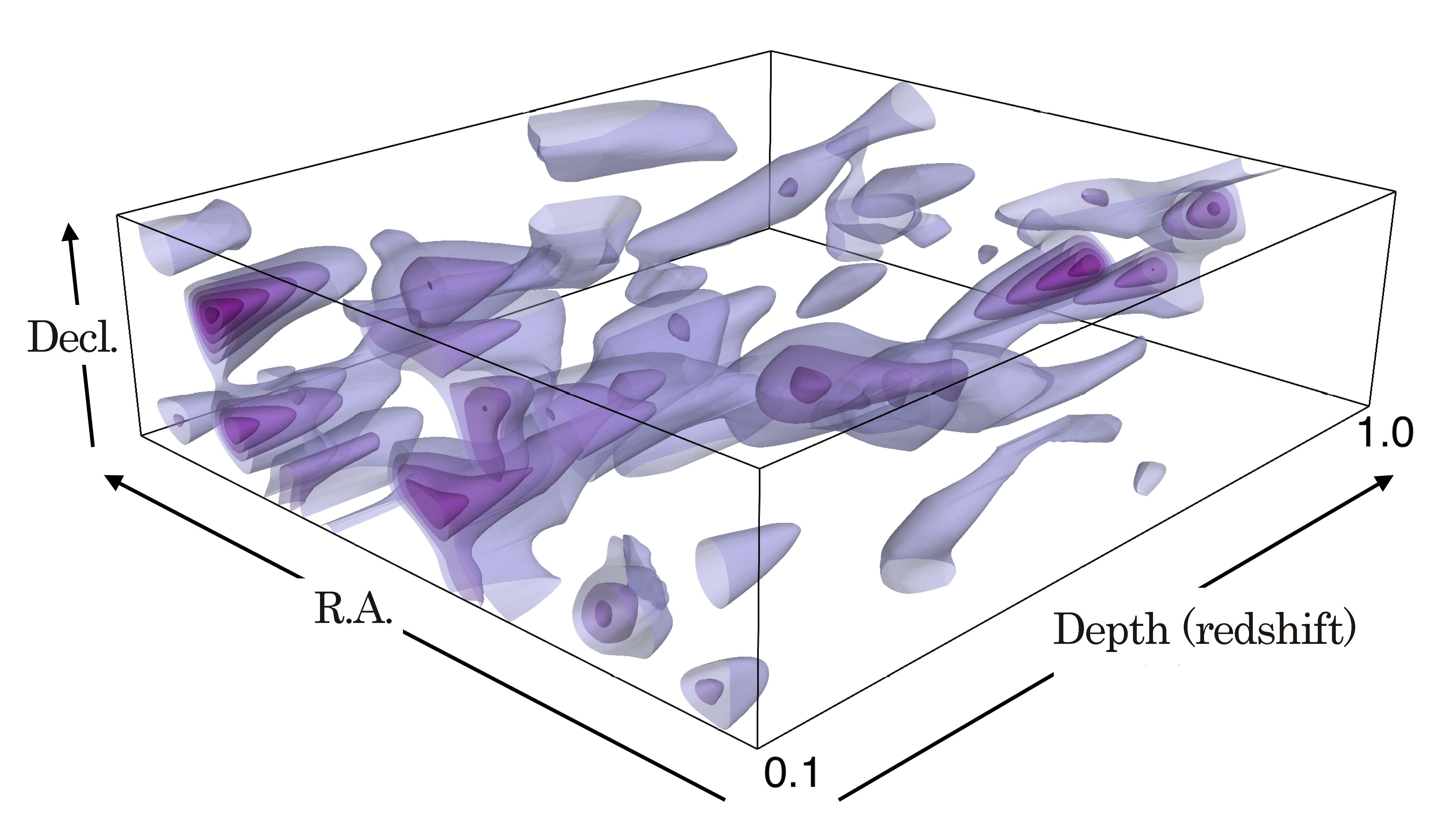An international team of astrophysicists and cosmologists at various institutes including NAOJ and the Kavli Institute for the Physics and Mathematics of the Universe have submitted a set of five papers, measuring the value for the "clumpiness" of the Universe’s dark matter, known to cosmologists as S8. The reported value is 0.76, which aligns with values that other gravitational lensing surveys have found by looking at the relatively recent Universe — but it does not align with the value of 0.83 derived from the Cosmic Microwave Background, which dates back to when the Universe was about 380,000 years old. The gap between these two values is small, but it doesn’t appear to be accidental. The possibilities are that there’s some as-yet unrecognized error or mistake in one of these two measurements or the standard cosmological model is incomplete in some interesting way.
The standard model of our Universe is defined by only a handful of numbers: the expansion rate of the Universe, a measure of how clumpy the dark matter is (S8), the relative contributions of the constituents of the Universe (matter, dark matter, and dark energy), the overall density of the Universe, and a technical quantity describing how the clumpiness of the Universe on large scales relates to that on small scales. Cosmologists are eager to test this model by constraining these numbers in various ways, such as by observing the fluctuations in the Cosmic Microwave Background, modeling the expansion history of the Universe, or measuring the clumpiness of the Universe in the relatively recent past.
A team led by astronomers from Kavli IPMU, the University of Tokyo, Nagoya University, Princeton University, and the astronomical communities of Japan and Taiwan, spent the past year teasing out the secrets of the most elusive material, dark matter, using sophisticated computer simulations and data from the first three years of the Hyper Suprime-Cam Subaru Strategic Program (HSC-SSP). The observation program used one of the most powerful astronomical cameras in the world, Hyper Suprime-Cam (HSC) mounted on the Subaru Telescope. The HSC-SSP data that the research team used covers about 420 square degrees of the sky, about the equivalent of 2000 full moons.

Figure2: An example of a 3D distribution of dark matter derived from HSC-SSP. This map is obtained by using the first year's data, but the present study examined an area on the sky about three times larger than that. (Credit: University of Tokyo/NAOJ)
Clumps of dark matter distort the light of distant galaxies through weak gravitational lensing, a phenomenon predicted by Einstein’s General Theory of Relativity. This distortion is a really small effect; the shape of a single galaxy is distorted by an imperceptible amount. But the team measured the distortion with quite high precision by combining the measurements for 25 million faint galaxies that are billions of light-years away. Then, the team measured the clumpiness of the Universe today (Figure3).

Figure3: The measurement results of S8 parameter from HSC-SSP Year 3 data. The chart shows the results from four different methods, which used different parts of the HSC-SSP Year 3 data or combined the HSC-SSP Year 3 data with other data. For comparison, "Planck CMB" shows the measurement result for S8 from the cosmic microwave background data from the Planck satellite. "Other weak lensing results" shows the results from similar weak lensing measurements based on the Dark Energy Survey (DES) and Kilo-Degree Survey (KiDS) data. (Credit: Kavli IPMU)
The discrepancy between the S8 values of HSC-SSP and the Planck satellite is very subtle.
The team thinks that the measurement was done correctly and carefully. And the statistics show that there’s only a one in 20 probability that the difference is just due to chance, which is compelling but not completely definitive. The team will further pursue this compelling inconsistency using the full HSC-SSP data set and refined methods. The team might discover something new about the Universe, so please stay tuned.
These results appeared as five papers available on a preprint server. They were submitted to Physical Review D and will undergo rigorous peer review by the scientific community.
Miyatake, H., Sugiyama, S. et al. "Hyper Suprime-Cam Year 3 Results: Cosmology from galaxy clustering and weak lensing with HSC and SDSS using the emulator based halo model"
More, S., Sugiyama, S. et al. "Hyper Suprime-Cam Year 3 Results: Measurements of the clustering of SDSS-BOSS galaxies, galaxy-galaxy lensing and cosmic shear"
Sugiyama, S. et al. "Hyper Suprime-Cam Year 3 Results: Cosmology from galaxy clustering and weak lensing with HSC and SDSS using the minimal bias model"
Dalal et al. "Hyper Suprime-Cam Year 3 Results: Cosmology from cosmic shear power spectra"
Li, X. et al. "Hyper Suprime-Cam Year 3 Results: Cosmology from cosmic shear two-point correlation functions"
This research was supported by the National Science Foundation Graduate Research Fellowship Program (DGE-2039656); the National Astronomical Observatory of Japan; the Kavli Institute for the Physics and Mathematics of the Universe; the University of Tokyo; the High Energy Accelerator Research Organization (KEK); the Academia Sinica Institute for Astronomy and Astrophysics in Taiwan; Princeton University; the FIRST program from the Japanese Cabinet Office; the Ministry of Education, Culture, Sports, Science and Technology (MEXT); the Japan Society for the Promotion of Science; the Japan Science and Technology Agency; the Toray Science Foundation; and the Vera C. Rubin Observatory.
The Subaru Telescope is a large optical-infrared telescope operated by the National Astronomical Observatory of Japan, National Institutes of Natural Sciences with the support of the MEXT Project to Promote Large Scientific Frontiers. We are honored and grateful for the opportunity of observing the Universe from Maunakea, which has cultural, historical, and natural significance in Hawai`i.



